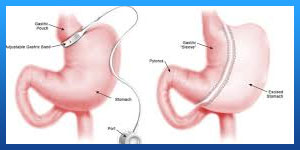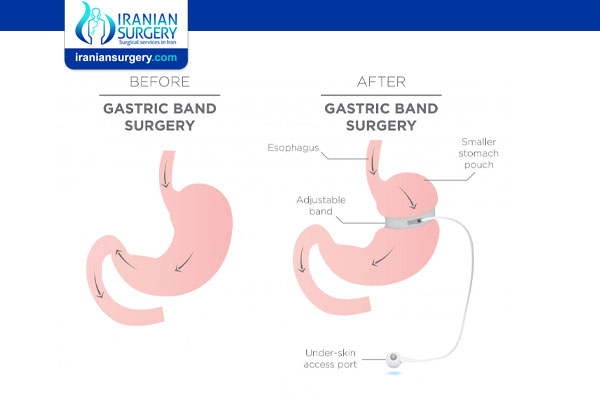What are the long term effects of lap band surgery?
What are the side effects of a gastric band?
Does stomach banding work?
Gastric banding surgery pros and cons
What are the cons and pros of gastric banding surgery?
Advantages
There are many advantages to using an adjustable gastric band placement as a way of fighting obesity. The amount of food that can be held in a patient’s stomach is greatly reduced with the device in place without the need to permanently remove parts of the stomach or re-rout the intestine — a feature considered to be the most attractive compared to more invasive weight loss procedures.
The average achievement for the gastric band is 40 to 50 percent of excess weight loss, which can result in improvement of comorbidities like insulin resistance, type 2 diabetes, hypertension, dyslipidemia, cardiovascular disease, stroke, sleep apnea, gallbladder disease, hyperuricemia, gout, and osteoarthritis, and overall health.
The surgery also requires a shorter hospital stay, usually less than 24 hours, with some centers discharging the patient the same day as surgery, while it is among the FDA-approved bariatric procedures with the lowest rate of early postoperative complications and mortality, as well as lowest risk for vitamin and mineral deficiencies. In addition, an adjustable gastric band is a reversible and adjustable process, unlike other bariatric surgeries that are permanent.
Read more about : Gastric balloon side effects
Read more about : Mini gastric bypass surgery side effects
Read more about : Gastric balloon diet
Disadvantages
However, the gastric band also has cons, starting with the fact that the device is associated with slower and later weight loss than other surgical procedures, which can sometimes impact patients’ motivation to remain compliant with the program. Similarly, some patients that use the adjustable gastric band fail to lose at least 50 percent of excess body weight compared to the other surgeries commonly performed.
In addition, it is one of the methods that requires patients to hold a foreign device inside their bodies, which can be uncomfortable and a “strange” experience for some patients. Several side effects are also associated with the band, including band slippage or band erosion into the stomach, which occurs in a very small percentage of patients, as well as dilatation of the esophagus if the patient overeats.
Patients may also suffer mechanical problems with the band, tube or port in a small percentage of patients and it requires strict adherence to the postoperative diet and to postoperative follow-up visits in order to guarantee successful results and avoid potential side effects related to the band. However, due to complications that need to be surgically corrected, adjustable gastric band is also the bariatric surgery with highest rate of re-operation, according to the society.
Can you keep a gastric band in forever?
A: Gastric bands do not last forever. A gastric band that deteriorates can kill or seriously harm a patient if it is not removed. Researchers at the European School of Laparoscopic Surgery studied patients with gastric banding devices for 12 years.
Is Gastric Banding safe?
Not permanent — the gastric band can be removed at any time, unlike other weight loss surgeries, such as sleeve gastrectomy, which permanently change the digestive tract. Proven safe — most weight loss surgeries are safe and have low mortality rates, but the gastric band’s .1% mortality rate is compelling for patients.
How long does a gastric band operation take?
30 to 60 minutes It is performed through keyhole incisions. The surgeon makes between one and five small surgical cuts in the abdomen. Surgery is carried out using a laparoscope, a long narrow tube with a camera. The procedure often takes 30 to 60 minutes.
What is long term success rate of weight loss surgery?
In general, the success of weight-loss surgery is sometimes defined as achieving a 50 percent loss or more excess body weight and maintaining that level for at least five years.
Can you drink alcohol with a gastric band?
When you get permission to start drinking alcohol again, avoid carbonated beverages and sugary drink mixers. Remember that after surgery, even small amounts of alcohol can cause intoxication and low blood sugar. Never drink and drive, even after consuming only minimal alcohol.
Is a gastric band dangerous?
The insertion of a gastric band is a surgical procedure and, although rare, carries potential risks. … The main complications that can occur following gastric weight loss surgery include infection, blood clots in the legs (deep vein thrombosis) or lungs (pulmonary embolism) and internal bleeding.
Can liposuction get rid of belly fat?
Liposuction permanently removes fat cells, altering the shape of the body. However, if the patient does not lead a healthy lifestyle after the operation, there is a risk that the remaining fat cells will grow bigger. The amount of fat that can be safely removed is limited.
How can I reduce my stomach fat?
20 Effective Tips to Lose Belly Fat (Backed by Science) Eat Plenty of Soluble Fiber. … Avoid Foods That Contain Trans Fats. … Don’t Drink Too Much Alcohol. … Eat a High-Protein Diet. … Reduce Your Stress Levels. … Don’t Eat a Lot of Sugary Foods. … Do Aerobic Exercise (Cardio) … Cut Back on Carbs, Especially Refined Carbs.
What can you eat after a gastric band?
You will eat only liquid or pureed food for 2 to 3 weeks after your surgery. You will slowly add in soft foods, and then regular foods.
What are the side effects of gastric band surgery?
What are the side effects of gastric banding surgery? Nausea and vomiting. These can often be reduced by adjusting the tightness of the band. Minor surgical complications. These include problems with the adjustment device, wound infections, or minor bleeding. They happen less than 10% of the time.



2 Responses
can i eat normal food a few weeks after surgery, or will i have to permanently diet ?
Hello
You need to be on a strict diet, for at least 6-7 weeks, even more, you have to be in touch with your nutritionist